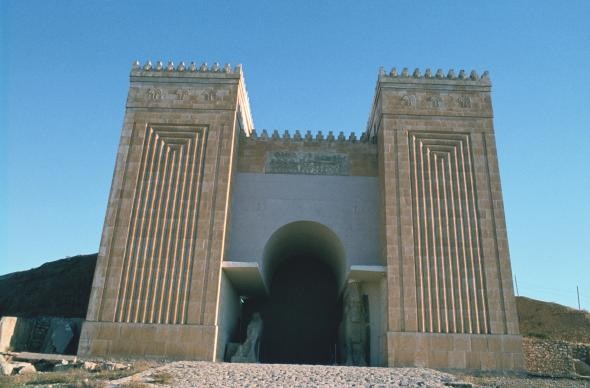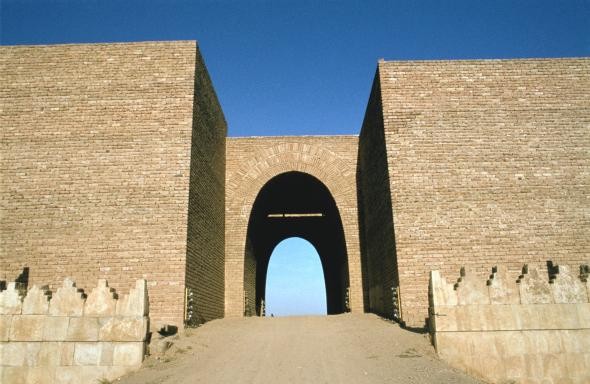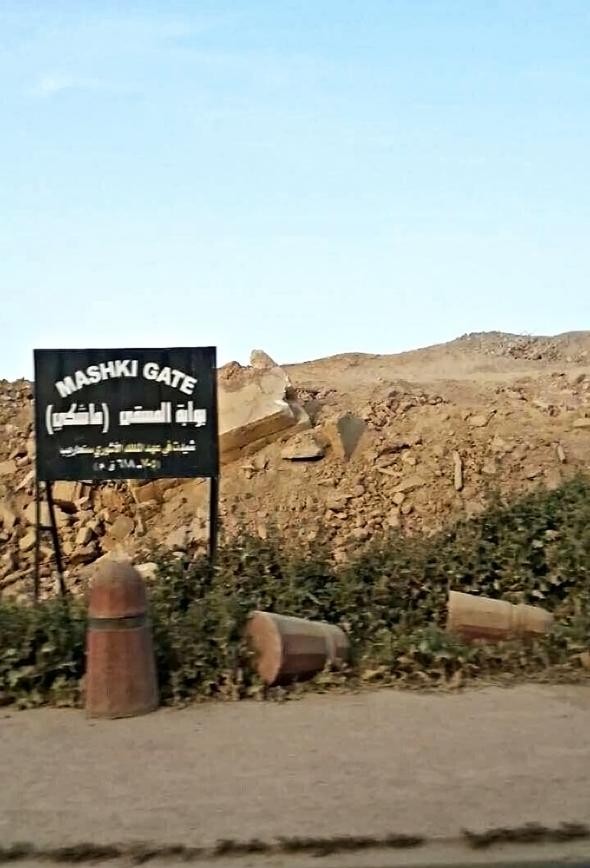
The Nergal Gate in Nineveh was originally built around 700 B.C. and reconstructed in the 20th century. The citizens of the surrounding city of Mosul consider themselves descendants of the ancient Assyrians who built Nineveh. Photograph by Heritage Images, Getty Images
ishtartv.com-
news.nationalgeographic.com
Kristin
Romey ,April 19, 2016
As
the Iraqi army advances on Mosul, militants attack one of its best-known
monuments.
National
Geographic has received exclusive photographs that appear to confirm
the destruction of the Mashki and Nergal Gates by the
Islamic State (ISIS) at the ancient site of Nineveh in Iraq. (Why
does ISIS hate archaeology?)
Unconfirmed
reports of the destruction of Nineveh's iconic gates began to emerge
late last week but were just
confirmed by Michael Danti, professor of archaeology at Boston
University and co-director of the Cultural Heritage Initiative (CHI)
at the American
Schools of Oriental Research. The Initiative works with the U.S. Department
of State to document destruction of cultural and
religious sites in Iraq and Syria.
"We
can verify for now that the Mashki and Nergal Gates have
been destroyed," says Danti, based on the images obtained by the
CHI and corroborated by "trusted sources" in Mosul, the
ISIS-occupied city that surrounds Nineveh. (Learn
why the Mosul Dam may be the greatest threat to the city.)
In
an image of the destroyed Nergal Gate, an earthmover is clearly
visible.
An
Assyrian Symbol, Ancient and Modern
Nineveh
was already an important urban center more than 4,000 years ago,
and at its height around 700 B.C. was a capital of the Neo-Assyrian empire
and the largest city in the world.
The
city featured numerous temples and the sprawling 80-room
palace of King Sennacherib, all surrounded by a wall 7.5 miles (12
km) long punctuated by 15 gates.
The Mashki Gate,
known as the "Gate of the Watering Places," may have been
used to lead livestock to the nearby Tigris River. The Nergal Gate
takes its name from the Mesopotamian god of death
and the underworld.
Sennacherib's reign
was marked by his siege of Jerusalem in 701 B.C. and is recorded
in Assyrian sources and in
the Bible, which also describes the prophet Jonah's visit to
Nineveh. The city was sacked in 612 B.C. by a
While the
gates of Nineveh were rebuilt in the
20th century, they remain prized symbols of the
ancient heritage of the residents of modern Mosul.
"Both
the Arab Muslim and Arab Christian population [of the
area] trace their ancestry back to the Assyrians,"
says Danti. "It's part of their modern identity."
A
Scorched Earth Policy Ahead of an Advancing Army
As
the Iraqi army makes plans to liberate Mosul from the control of the Islamic
State, there are unconfirmed reports that other gates and walls in
Nineveh are also being plowed under.
"It's
reasonable to assume that [ISIS] is destroying other gates [in
Nineveh], but we need to get more information before we can make those
assertions," Danti adds.
"[ISIS]
is essentially sending a signal to the government of Iraq that if they
continue with their offensive on Mosul they can expect a scorched earth policy
from Islamic State, in both Mosul and the Iraq theater but
also in Raqqa in the Syrian theatre," he says.
Deliberate
destruction of monuments by ISIS has been recorded since the Islamic
militants first seized Mosul in June 2014. A mosque dedicated to the
prophet Jonah inside the walls of Nineveh was destroyed by
ISIS in July 2014.
Sculptures
from the site were damaged during ISIS'
rampage through the Mosul museum in February 2015, including the
famous half-human, half-animal statues that flanked
the Nergal Gate. The militants have also destroyed the city's
main libraries, which contained centuries-old manuscripts.
According
to Danti, the Islamic State's scorched earth
policy is psychological warfare intended to give the
appearance that they are in control and to make onlookers feel
powerless.
Misinformation
and unsubstantiated rumors on social media add to the anxiety the
militants want to provoke. "I think we should expose what
they're doing," says Danti, "and not let it be a mystery."

The Nergal Gate after its destruction by the Islamic State. An earthmover is visible in the distance. Courtesy of ASOR Cultural Heritage Initiatives

Ancient Nineveh's inhabitants may have led animals through the Mashki Gate to water at the nearby Tigris River. Photograph by Heritage Images, Getty Images

A sign indicates the location of the destroyed Mashki Gate. Courtesy of ASOR Cultural Heritage Initiatives
|